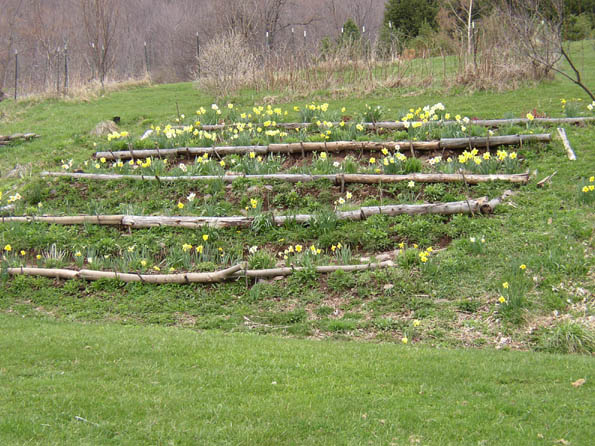When I wrote about the bank garden in March, it was still winter. Now spring, with all her vagaries has come to Halcott, and of course that means mild breezes kissed by the warm sun, followed by cold stinging sleet. Ah, the duplicities of spring, the perfidies of prima vera! The bank was battered by a rainstorm on April 2nd that not only dislodged many of the pine logs from their moorings, but also washed away much of the soil they held up. It is an arrangement not yet perfected. I have replaced many of the logs with some ash trunks rescued from the side of the road that had been destined by the highway crew for the chipper. Ash is straighter and more enduring. Maybe.

But what of the plants? The daffodils as you can see, are still coming on. I cannot think of a better beginning to a cold-climate spring than the noble daffodil: golden harbinger of the gardening season. They have been blooming here since about April 18th, and I have some planted on the north side of a stone wall who have not yet even opened. They give brightness and joy for a good six weeks and when they finally turn to messy foliage, there is so much else going on around them that I don’t care. Nevertheless, it has not been the best spring for daffodils. They had a spell in April when the weather was so deceitfully warm that they burst forth too hurriedly. The next week some heavy wet snow bowed them to the ground. Daffodils are good sports, regaining consciousness as soon as the temps grow mild again, but no one can take such a battering without a little lessening of spirit… The bottom layer has been slow to bloom. These were the ones I put in last autumn, and in my experience, newly planted daffodils are always tardy the next spring.
In the top row, the peonies are on the rise — great voluptuous red upsurgings that suggest the powerful display that they will become. The daylilies are all up. Their foliage best rewards a gardener’s eye in spring with its new green freshness. Some delphiniums that I started last year from seed have returned. Hallelujah! Blue is very necessary in this garden of fruit colors. The Siberian iris row has new greenery of a completely different nature than the daylilies above it — the blue-gray spears come forth a little later but are more delicate. The Asiatic lilies that I bragged about in my last posting don’t seem to be very much in evidence yet. I’m hoping that they’re just waiting for more reliable weather. Me, too…
The layer next to the bottom will hold my dahlias, and so it continues to look a little empty. The bottom layer has some nice surprises including a deep plum euphorbia — “Chameleon” I believe that it’s called. In the hopes of inserting more blue, I have been trying to get larkspur started in this bank garden. It has been known to reseed itself in other places reliably, and then suddenly, it’s gone. To my mind, though, it is definitely worth extra effort: it grows through and around plants and its intense blue is most welcome. For two years, I’ve sown it assiduously on the bank, usually on April 15th to mark the end of tax season, but the results have been disappointing. This year I waited until rain was forecast and then mixed into a wheelbarrow filled with enriched soil 1 seed packet each of larkspur, annual bachelor buttons and cosmos (certainly not blue, but of which I seem to have many complimentary seed packets and who can have too much cosmos?), and sprinkled shovel-fuls over each layer of the bank. The rain I’m hoping did the rest. I will report on this experiment if I remember to. Which I won’t unless the results can be seen.
The bank will need periodic weeding, but other than that, it is essentially set for summer. Meanwhile, I have been spending time doing other garden chores such as raking autumn leaves off existing beds and making more beds. This past weekend, I made a cotter pin garden. I’m heavily into curves nowadays, and I may have put one too many into this new garden, hence the name, for it looks just like one of the giant cotter pins that holds my husband’s tractor together.
Stepping back and looking everything over, I see that my garden reveals much about my character. I suffer from bite-off-more-than-can-chew disease. Although I never have enough garden space I also never have enough time to take care of all the garden space. This illness is bad enough, but even more destructive is my total disregard for thoughtful pre-planned action. I can make as many garden graphs/drawings as I like, but once out in the dirt, I seem to forget them all! This is absolutely maddening when plant orders come. I had counted on them for one spot and willfully ignoring this, I place them in a completely different spot. Which requires far-flung re-arrangements, taking from here and there, replacing this and that. It adds up to a wonderful day of dirty fingernails and sore muscles. And, I must admit, exaltation. What forgiving joy! Perhaps gardening is the only instance where blatant character flaws have delicious consequences.




Dear Cynthia: The bank garden is situated behind and beside the house, so that it can be seen from the road. If I do my job right, it should be stopping traffic come June/July. I hope to post another picture! Thanks for your comment.
Where exactly is this bank – in the front or back? I’m trying to jog my memory of 12 years ago! Of course our daffodils are LONG gone! Yours look lovely – please post another picture when the peonies, irises, and daylilies are in bloom.
bite-off-more-than-can-chew disease
Isn’t that the definition of a gardener?